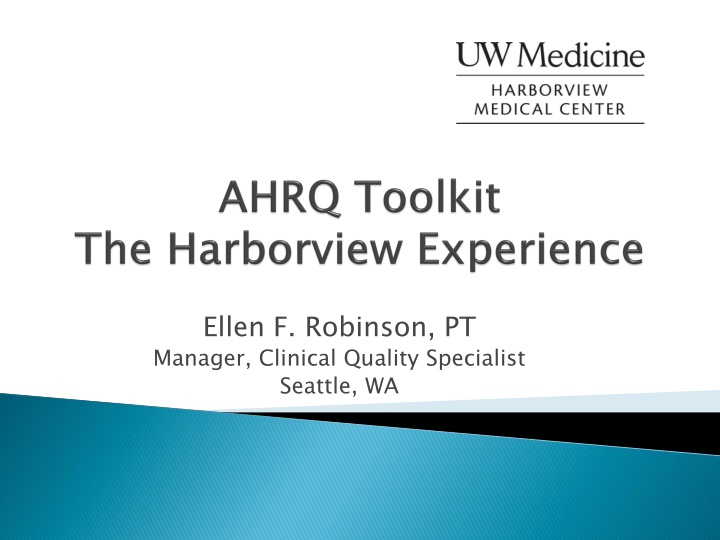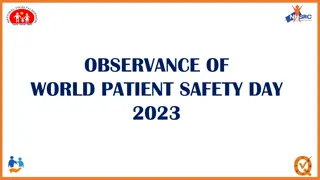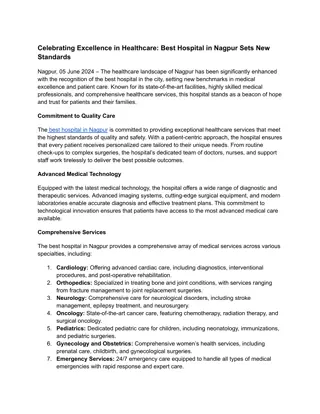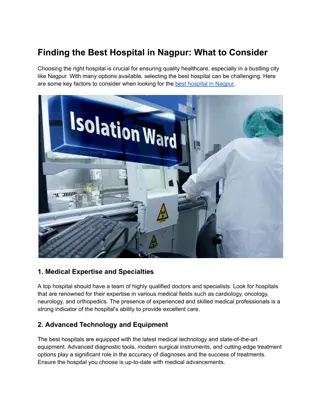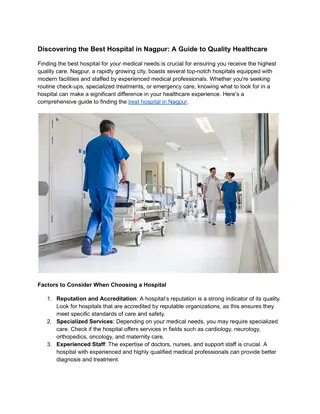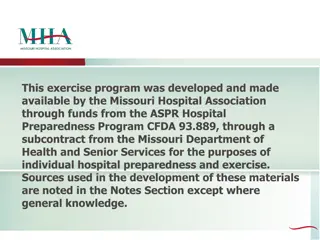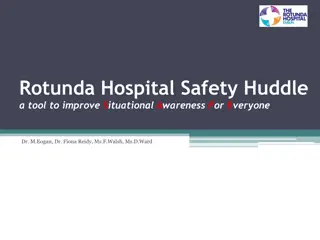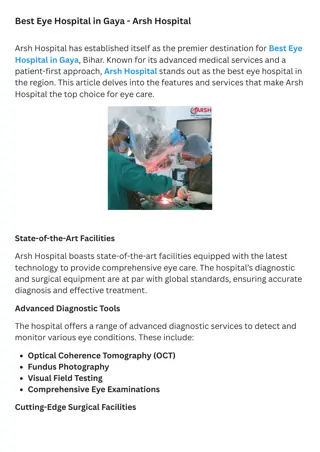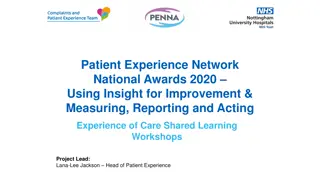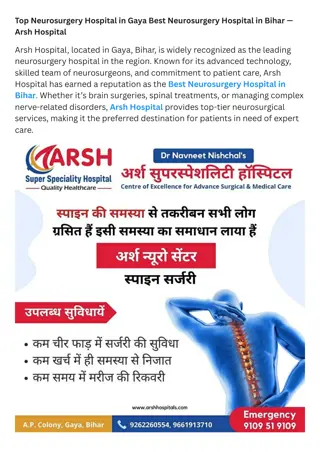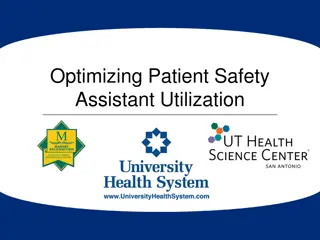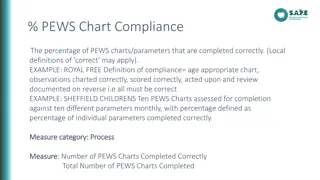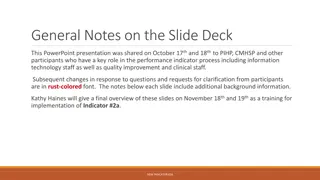Utilizing AHRQ Patient Safety Indicator Data for Hospital Quality Improvement
Utilization of AHRQ Patient Safety Indicator (PSI) data to enhance hospital quality, operationalize PSI reviews using the AHRQ Toolkit, identify opportunities for enhancing patient care, and integrate PSI metrics into quality improvement initiatives across academic and community healthcare settings.
Download Presentation

Please find below an Image/Link to download the presentation.
The content on the website is provided AS IS for your information and personal use only. It may not be sold, licensed, or shared on other websites without obtaining consent from the author.If you encounter any issues during the download, it is possible that the publisher has removed the file from their server.
You are allowed to download the files provided on this website for personal or commercial use, subject to the condition that they are used lawfully. All files are the property of their respective owners.
The content on the website is provided AS IS for your information and personal use only. It may not be sold, licensed, or shared on other websites without obtaining consent from the author.
E N D
Presentation Transcript
Ellen F. Robinson, PT Manager, Clinical Quality Specialist Seattle, WA
Discuss utilization of the AHRQ Patient Safety Indicator (PSI) data to develop a high level enterprise measure of hospital quality Provide examples of how to utilize the AHRQ Toolkit to operationalize PSI review Discuss how to utilize PSI information to identify opportunities to improve patient care Confidential: Quality Improvement 2
Mission and Priority of care Confidential: Quality Improvement 3
July 2011 PSI Project Full Integration July 2010 AHRQ Toolkit Project July 2009 Oh I wish I had a toolkit July 2008 WHAT IS A PSI? Confidential: Quality Improvement 4
2013 2012 2012 to 2014 Integrated a PSI Metric as a marker of Patient Safety Spans the UW Medicine Enterprise:2 Academic Medical Centers & 2 Community Hospitals Consistently reviewed at Board and Leadership Meetings Confidential: Quality Improvement 5
External Reporting Internal Case Identification Medical QI Committee (MQIC) Departmental M&M review/report Standard identification of potentially preventable harm events for clinical review Tracking of outcomes of reviews for trending of possible opportunities Confidential: Quality Improvement 6
IQI/PSI Fact Sheets AHRQ Specification Guidelines Readiness to Change (Self Assessment) Medical Director - previous director of QI Dept Leadership Support and directive for project The Board was on board Challenges identified: information dissemination about quality and patient safety to staff at all levels of the organization Confidential: Quality Improvement 7
Utilizing UHC database to track rates for PSI UHC Quarterly Summaries ~ 3 months behind Individual Case review ~ 6 weeks behind Too late to make an impact How do we get PSI data in real time ? Can we use our internal data and the AHRQ software and get the same results? Confidential: Quality Improvement 8
Internal Source System for data points (3M) 3M Report output= 2 pages, multiple Rows PERL Script to transform into usable input file AHRQ Software is free and easy to download, but each hospitals source system may be slightly different IT Resources may be required for mapping Confidential: Quality Improvement 9
Validate Numerator and Denominator against publically reported values Quality Improvement Projects Track each PSI cases individually for possible opportunities to improve care **Version changes and updates Confidential: Quality Improvement 10
HMC Project Originally utilized UHC as source UHC runs the SAS version software on each hospitals administrative data set Confidential: Quality Improvement 11
HMC Highest Prioritization scores: PSI 3 PSI 7 PSI 12 Have since focused on PSI 11 PSI 13 and PSI 15 Confidential: Quality Improvement 12
Presented to Surgical Council, Medical Executive Board, Critical Care Council, Hospital Board, Clinical Documentation Specialists, Coding What are the PSIs? Why do we care? Current performance/UHC ranking How are we going to review/expectations from teams Possible opportunities for improvement Clinical areas Documentation Clinical areas Documentation - -Coding Coding Confidential: Quality Improvement 13
Examples of effective PSI improvement strategies Evidence-based best practices for selected PSIs Improvement Methods Overview Implementation Team Charter and Goals Selected Best Practices Gap Analysis Implementation Plan Implementation Measurement Confidential: Quality Improvement 14
Forming Implementation Teams (Task Forces) Who are the experts in these areas? Who are the experts in these areas? PSI 03: Clinical Nurse Specialists wound care PSI 07: Infection Control PSI 12: Anticoagulation Task force: Trauma Surgeon, Hospitalist, Pharmacy, Nursing PSI 11: Spine Surgeon, Anesthesia, Respiratory PSI 13: Sepsis Team: MD, CNS, Patient Safety PSI 15: Surgeons, Clinical Document, Coding Confidential: Quality Improvement 15
Understand PSI Definitions Consider how coding and documentation impact PSI rates Validation of Event Cases Consider specific populations Confidential: Quality Improvement 16
Run Input file through AHRQ Software 10 days after previous month for case identification Upload PSI internal database to track outcomes Providers report up through M&M conferences and Medical Quality Improvement Committee Confidential: Quality Improvement 17
No Event No Coding Issue Monthly Data Feed AHRQ Coding or Documentation issue? QI Analysis Documentation Coding Review Agree? Real Event? Service Review (Wrong code or exclusion criteria code missing) Update coding QI Concerns No QI Concerns Confidential: Quality Improvement 18
High rate of PSI events = quality issue at a hospital? Are all PSI events preventable ? Are all PSI events preventable ? * Web based tool for Quality Metrics reporting Confidential: Quality Improvement 20
Review PSI 12 events standard of care met? Compliance with UW Medicine guidelines for Prophylaxis Type? Prophylaxis Timing? Dose intensity? Mechanical when Chemical contraindicated? Categorize Opportunities Refer for further review as needed QI Confidential 21
How can you measure the impact of PSI reduction? UW Medicine Finance Annual Process Review Simple safety projects across the 4 hospital systems Raw count differential X $$ = cost savings Greatly valued by executive team Simple comparison to measure the impact of Confidential: Quality Improvement 22
Reviewed by our Research Librarian Incorporated into University of Washington Health Sciences Healthcare Quality News Pub Med Searches (preselected QI topics) eJournals related to quality and safety PubMed Notifications for specific topics Measures links to TJC, NQF, CMS, UHC, IHI, WSHA, Publishing/RefWorks/EndNote Health Sciences LibGuides LibGuides web page http://libguides.hsl.washington.edu/qualitysafety Confidential: Quality Improvement 23
Validate, validate, validate Leadership backing for project importance and accountability from providers Presentations to clinical providers should focus on actual clinical events and outcomes Coding department project lead/liaison with clinical documentation specialists involvement Customize task forces to address specific PSI categories and determine preventability Confidential: Quality Improvement 24
Harborview Medical Center Dr. J. Richard Goss Dr. Anneliese Schleyer Dr. Joseph Cuschieri Ronald Pergamit, QI/IT Derk Adams, QI/IT Patty Calver QI Ellen F. Robinson (206) 744 9550 lnrobin@u.washington.edu Ellen F. Robinson (206) 744 9550 lnrobin@u.washington.edu Confidential: Quality Improvement 25
